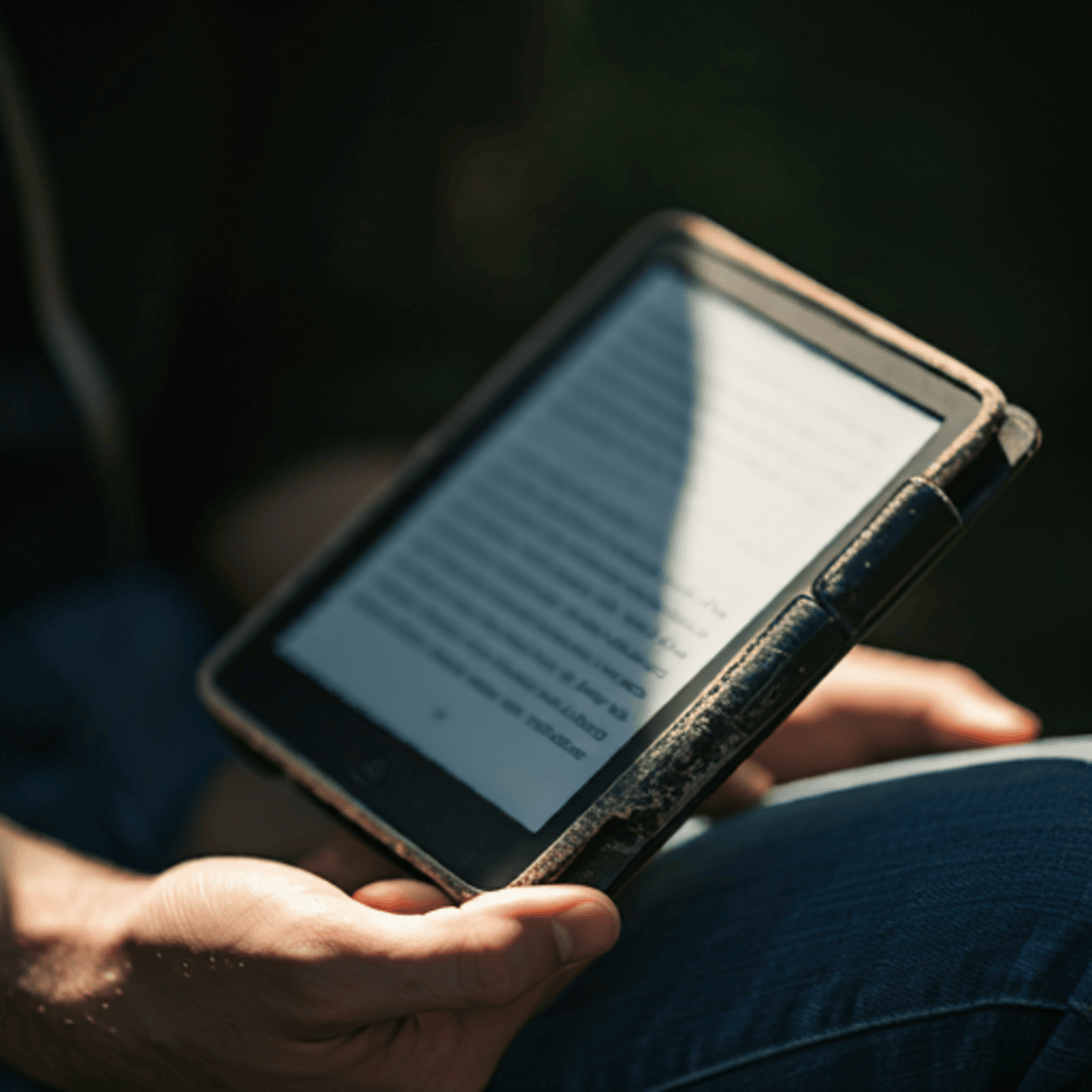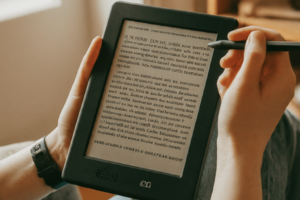Regarding readability, analyzing the e-reader display technology types and their advantages is vital. E-reader display technology is principally categorized into two parts: E-Ink and LCD. Each category bears distinctive specifications that have a bearing on the readability levels and the user experience. E–Ink technology is famous in that it can simulate the appearance of ink on paper by utilizing ambient light, thus enhancing the readers’ comfort.
Table of Contents
*****Disclosure: This post may contain affiliate links, which means we may receive a commission, at no extra cost to you, if you make a purchase through a link.****
Hence, although LCD screens are rich in colors and resolution, they tend to attract a lot of glare and do not support lasting usage. Being equipped with such knowledge enables the readers to be able to choose an e-reader display technology that is suitable for their reading patterns and practices. With such developments and due to the rapid changes in e-reader display technology, it is important to know what changes are there to enhance the reading experience.
Where other electronic reader display technologies fail to meet performance standards, e-ink technology performs exceptionally well in that respect. Rather than using an alphanumeric pattern all the time as the liquid crystalline display screens do, E-Ink displays employ microcapsules containing black and white particles arranged to depict pictures or letters. This technology allows for bright contrasts without causing reflections making it comfortable to use outdoors even on bright sunny days. Finally, E-Ink displays do not produce any artificial glare and have a soft warm color like paper which is quite comfortable for the user.
Therefore, this type of technology is more suitable in cases of prolonged reading. So E-Ink is still the best option for those who need a display technology that will not tire their eyes yet is effective. In particular, this technology’s advantages of papery effects are ideal for book lovers.
Disclosure: This post may contain affiliate links, which means we may receive a commission, at no extra cost to you, if you make a purchase through a link.
E-Ink Technology Advantages
E-Ink technology is famous for simulating the appearance of ink on paper, enhancing reader comfort. It offers bright contrasts without causing reflections, making it ideal for outdoor reading.
The Kindle Paperwhite showcases the advantages of E-Ink technology, offering an exceptional reading experience that closely mimics paper. Its glare-free display allows for comfortable reading in various lighting conditions, including bright sunlight, making it ideal for outdoor use. Users frequently praise its adjustable front light, which enhances readability without causing eye strain during long reading sessions. With impressive battery life lasting weeks on a single charge, the Kindle Paperwhite stands out as an excellent choice for avid readers seeking both comfort and convenience.
LCD vs E-Ink Displaying Devices in a Nutshell
Making comparative analysis of E-Readers it is also necessary to be aware of the potential advantages and disadvantages regarding the display quality. First, LCD screen technology claims better color rendering and resolution which is especially beneficial for multimedia applications and pictures with more colors. But using LCDs requires some caution due to the blue light they emit, which can cause eye strain. Some LCD tablets come with blue light filters to mitigate eye strain.
E-ink technology however is a more low glare solution that is easier to read under most conditions compared to LCD, which is more like reading a book. In other aspects like dedicated reading, E-Ink is usually better because it is not move more than the page and takes even less battery power. Knowing these differences in e-reader display technology will assist them in picking the most appropriate device for them depending on the situation.
Resolution and Pixel Density
Resolution and pixel density remain imperative elements vis-a-vis the e-reader display technology. More resolute and higher density entails sharper text and detail images which improves the readability. Reflective LCD displays are often used in low-power applications due to their energy efficiency, and they are compared with E-Ink displays for their ability to reduce power consumption. E-ink displays are fewer in resolution compared to the high-end LCD screens although comfortable reading can still be achieved.
The recent trends in e-ink technology have enhanced the pixel density making the pixels less pronounced enabling eye-friendly reading. This is because LCD screens are generally designed with high availability of resolutions and pixel density and this is an added advantage in matters dealing with graphics and text. These aspects of e-reader display technology need to be assessed for any reader intending to buy a particular e-reader as far as reading needs are concerned.
Screen Size and Aspect Ratio
Different e-reader display technologies are identified as suitable for different tasks, and readability depends on e-reader screen size and aspect ratio in particular. More space provided by larger screens allows more text to be crammed and less page turning to be done. On the flip side, it also renders the device less portable as bulkier screens tend to define the devices.
Another aspect to consider when designing a screen for an e-reader is the aspect ratio. Wright-Pye claims that the global e-reader has opted for benefit 4: 3 and benefit 16: 9 common among the ratios of e-readers. E-Ink screens tend to adopt a 4:3 ratio as it fits in between the usual book sizes and hence makes it easier to read. It is essential to understand the interrelationships of display size and aspect ratio in e-reader-display technology so that one can be able to choose a device compatible with his or her reading interests.
E-book Displaying Features
E-reader display technologies are characterized by two features called front lighting and backlighting which affect how well one can read in different circumstances. Many E-Ink screens include front lighting, which illuminates the surface of the screen from the front only and does not change the text’s overall contrast. This is good as they assist in reading, even in darker areas, without losing the essence of a book.
On the other hand, however, it applies to LCD screens and provides some backlight to the display screen which may create some undesirable effects such as glare, and sometimes cut out on some reading ability depending on the mode or surrounding light conditions. Though backlight allocation is spread evenly around the desk, it also leads to accommodative fatigue after a period of usage. Therefore, while evaluating e-reader display defects in terms of front lighting and backlighting, it is imperative to consider the current usability conditions that the readers are likely to use the device in.
Color Displays vs. Monochrome Displays
The choice between color and monochrome displays is, no doubt, another aspect concerning e-reader display technology. Monochrome E-Ink displays, which use electronic paper to create a reading experience similar to physical books, are so much loved for their excellent readability and less stress on the eyes even in the dark. These displays have the effect of enhancing the appearance of carried print media, enabling a long period of filtering out visual fatigue.
In contrast, color LCD screens allow bright images and enable users to watch supplementary materials, offering added entertainment for easy reads such as comic books, magazines, and children’s novels with pictures including motion books. However, color displays tend to cause faster power drainage and greater hyperopia. Choosing either color or monochrome e-reader display technology is primarily based on the reading habits of individuals as well as the particular genres of texts they consume the most.
Refresh Rate and Response Time
Although refresh rate and response time are the two most significant parameters concerning e-reader display technology. They determine how comfortable one will be reading from that display. As it pertains to e-readers, the refresh rate stands for the display’s frequency of being defibrillated, whereas the response time determines the period it takes for a given pixel to switch its color to another color. Most LCD screens come with small pixels that are presented with even more complicated images at a quicker refresh rate and lower response time, a performance that is advantageous in showing dynamic content.
On the other hand, when it comes to reading, E-Ink displays are the best options since the refresh rate for the content is not very high with flicker flicker-free screen. Among other advantages that have been highlighted before, the low refresh rate of the E-Ink technology allows for a long-lasting battery as well as less fatigue on the eyes. Observing these aspects of most e-reader display technologies eventually enables users to opt for ‘gears’ that provide, in their opinion, an impeccable trade-off between readability and performance of the device.
Battery Life Implications
It is quite apparent that when it comes to the evaluation of the various e-reader display technologies, how long the reading device can last without a recharge is quite imperative and one of the factors that need to be considered. E-Ink readers have the advantage of being energy efficient as it is often said, due to low energy usage. This is because the power is consumed only when the page is flipped in an E-Ink screen making it possible to use weeks of reading with one charge. In contrast, LCDs, which require a constant backlight while in operation and have higher refreshing rates, tend to be more power-hungry.
Thus, for the audience that tends to constantly use their devices, E-Ink technology would be beneficial when it comes to battery life. Illustrating the battery life implications for each e-reader display technology assists the users in selecting the right device per their reading styles and requirements.
First of all, let’s talk about durability and screen protection. These two features of the e-reader display technology in question are some of the factors that determine how long the device can be utilized and how effective it is going to be in use. One of the main strengths of the e-ink screen is its ability to withstand shocks when compared to the LCD. E-Ink screens do not break easily, but they are fully exposed, and liable to humidity and scratches.
For example, many models of e-readers with E-Ink technology are equipped with an additional protective screen or case to increase life expectancy. LCD screens however are prone to cracking and scratching and due to this more protection layers are added to prevent damage caused by mechanical impacts. It can be concluded that the display technology of e-book readers is highly developed and taking proper safety measures about the cover and screen protector will make sure the device will be in good condition for many years.
Levels of Contrast and Brightness
Two additional parameters determine the usability of an e-reader display technology – the levels of contrast and brightness. There is usually a high contrast between the text which is black, and the background, which is normally white. This increases the ease of reading the text and the level of discomfort is as low as possible. This level of contrast of E-Ink screens is quite stable because they are glare-free, making it easier to use them under various lighting conditions, including bright sunlight.
There are some e-readers in which it is possible to adjust the brightness levels and therefore customize the reading. On the other hand, more alterations of brightness and color contrast are possible with the use of other video devices for e-book reading. Thus, Evaluation of the Contrast and Brightness features of this e-reader display technology aids you in acquiring a device whose readability measures suit the reading environment.
Glare, Reflection, and Blue Light Filter Management
Effective glare and reflection management is an important aspect of the display is reasonable reading of e-readers. The e-reader display technology harnesses the physical processes to reduce the glaze of the screen. This is especially useful in the case of reading using E-Ink screens outdoors, as they are better suited for reading in direct sunlight compared to LCD screens. However, LCD screens are more prone to glare and reflections because of backlighting and glass screens. Anti-glare shields or matt finishes have become common in most of the recent works that have been based on LCD e-readers. There are plenty of such factors, but one of them is glare and reflection management of e-reader printing methods on paper.
Reading in e-Readers in Different Lighting Conditions, Including Direct Sunlight
When assessing technology concerning e-reader displays, it is equally important to consider how reading will be done in different lighting conditions. This is where E-Ink displays utilize ambient light to provide a comfortable reading experience in both bright and low light conditions. Most of the e-ink devices have a front light feature that enables reading in the dark without losing the clarity of the text. But they also have their backlight which is good for dark environments, but because of reflection and glare they don’t do very well in bright sunlit conditions. Evaluating the performance of different e-reader display technologies under such conditions will help you avoid the disappointment of acquiring a device designed for one lighting region.
Aspects of Price and Value for Money
Price and value for money are among the major factors in the selection of the most optimal e-reader display technology. In that regard, E-Ink readers tend to be quite cheap due to good readability and battery life at an affordable price. E-Ink technology provides a natural reading experience similar to traditional paper, making it ideal for extended outdoor use without straining the eyes. It is particularly efficient to read on an e-reader model with the said technology for extended periods with relatively fewer hours of eye use.
If it is affordable, not all will want an e-reader with a plain screen since LCD e-readers will market additional features like a colored screen and many videos. The cost versus benefits for each e-reader display technology enables the user to come up with logical choices. In this context, e-readers satisfying both price and functionality requirements are also available therefore e-readers delivering the best value for money can be obtained.
Iodyne Pro Mini External SSD Storage Comes With Built-in e-Paper Display




Pingback: E-ink vs. LCD e-readers - Battle of the Screens: Which is Better?
Pingback: Popular E-book Formats for E-readers